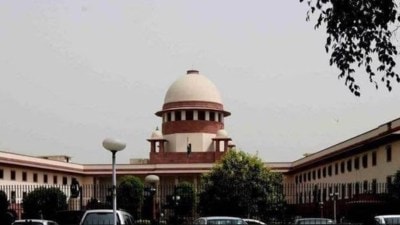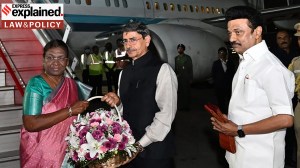Reform, make it farm fresh
Markets, industry and foreign institutional investors evidently dislike the electoral results. There is also a tendency to dislike democracy...

Markets, industry and foreign institutional investors evidently dislike the electoral results. There is also a tendency to dislike democracy. How can the public be so stupid as to vote out reforms? In Andhra Pradesh, Karnataka and even the Centre. Takes the sheen out of the feel good. Every commentator has argued, since the state elections in 2003, that this is the first time elections have been fought on issues of economic development and governance.
If that is a plausible hypothesis, Indian citizens have also delivered a fairly obvious economic message. By voting out the NDA and by bringing in the Left with a large number of seats. What the Left stands for is best left to the CPI and CPM to elucidate. Classic definitions of socialism involve public ownership of the means of production. Ipso facto, nationalisation, public sector enterprises and no privatisation. However, the Left also has a more broad-based concern about equity. Hence, the underlying message of the results is also that the growth process of the 1990s has been inequitable and that is a message that shouldn’t be ignored. In this entire privatisation discourse, how many people (in the workforce) are we talking about? 6.19 million. But the equity discourse concerns 400 million in the workforce. For understandable reasons, the Sensex reacts disproportionately to the 6.19 million. But any new government has to react at least proportionately to the interests of the 400 million.
Notions of equity have an absolute angle and a relative one. The absolute notion is that of poverty. Poverty is not a uni-dimensional concept, although it is often understood in the sense of income poverty, that is, percentage of people below the poverty line, known as the poverty ratio or head count ratio. Growth has an indirect trickle-down effect on poverty and, arguably, the reform process depended on growth to reduce poverty. Indeed, head count ratios did decline. Reliable data on head count ratios can only be obtained through National Sample Survey large samples and we had these in 1993-94 and 1999-2000. So we know the head count ratio dropped from 35.97 per cent in 1993-94 to 26.1 per cent in 1999-2000. Unfortunately, there are comparability problems between NSS methodology followed in 1993-94 and 1999-2000. Corrected for these, the head count ratio was probably around 29 per cent in 1999-2000. That is a significant drop. Nevertheless, even after the drop we have head count ratios in excess of 30 per cent in Arunachal Pradesh, Assam, undivided Bihar, undivided MP, Meghalaya, Sikkim, Nagaland, Orissa and undivided UP. Even West Bengal is pretty close to 30 per cent. If one sees district-level data, disparities become sharper still. And these segments of central, eastern and northeastern India also vote.
One can argue this isn’t fair. Bimaru states (Bihar, MP, Rajasthan, UP) have always been backward. It is sufficient that absolute standards improve in these states. But relative notions of equity also have relevance and that is captured in something like inequality. If income levels of the poor grow at slower rates than average improvements in income, it represents a relative worsening. Measured in income (or consumption) terms, India is relatively egalitarian. The share of the poorest 10 per cent in aggregate consumption is 8.1 per cent, higher than comparable figures in Russia, China or the US. The Gini coefficient is an overall measure of inequality and at 0.341 in urban India and 0.258 in rural India, the Indian inequality in distribution of consumption expenditure is also relatively low. But this is at the aggregate level.
The issue is not so much that of aggregate inequality. Instead, because income or consumption growth has been uneven across regions, castes and gender, it is these forms of inequality that are of concern. Spice that with enhanced expectations that hype over India Shining generates. If parts of India have already become a developed economy, farmers who commit suicide, women who fight over free saris and those who hanker after a few measly jobs in railways rightly feel alienated, marginalised and bypassed.
Three more points need noting. First, growth hasn’t been that spectacular. Four per cent growth in 2002-03 and even 9 per cent in 2003-04 gives an average rate of just 6 per cent. Nowhere near the 6.8 per cent the Eighth Plan (1992-97) gave us or the 8 per cent the Tenth (2002-07) promised us, though a shade better than the 5.6 per cent the Ninth delivered. Therefore, the counterfactual argument. Had growth been as high as that achieved during the Eighth Plan, poverty ratios would have been much lower. Second, the composition of growth is important. Between 1993-94 and 1999-2000, the employment elasticity of growth declined and the promised 10 million jobs a year failed to materialise. Nowhere is this as evident as in the agriculture cum rural sector. In that period such jobs as were created were in construction and in services like trade or transport. Agriculture may account for only 25 per cent of GDP. But 70 per cent of the population works in the rural sector and for those who have limited skills, real incomes have actually declined. Third, reforms are not about the state abdicating responsibility in social sectors like health, education, physical infrastructure like water, roads and electricity. Such abdication has de facto happened. Where is the 6 per cent of GDP to be spent on education and 4 per cent on health? Where are the direct anti-poverty programmes?
Stated differently, the argument that these results are anti-reform is simplistic. Not unless one explains what one means by reforms. If reforms are interpreted as privatisation and revamping Chapter V-B of the Industrial Disputes Act, they are indeed anti-reform. But these are small components in the pending reform agenda. If reforms are interpreted as introducing liberalisation in the rural sector, there is no reason why liberalisation should be postponed. Nor should it be postponed if it is interpreted as increasing public expenditure and making this expenditure more accountable and transparent, thereby improving its efficiency. In contrast to China, why are reforms in India perceived to be pro-rich, anti-poor? Because lives of most of India’s citizens have not yet been touched by reforms. The message is therefore about the contour of reforms, not about their continuation.
Photos




- 01
- 02
- 03
- 04
- 05



























